Cooler data centers help take the heat off electric bills

From streaming movies or games and sharing photos on Instagram to the growing use of "smart" devices and growth in artificial intelligence (AI) technologies, the amount of data being processed is escalating. As a result, energy consumption of data centers in the European Union (EU) is expected to rise from 2.7% of electricity demand in 2018 to 3.2% by 2030.
Cooling data centers can take up to 40% of their total energy consumption. "Cooling a data center is a big issue," said Xudong Zhao, professor of engineering at the UK's University of Hull. "You've got a lot of heat generated from the data center that needs to be removed … continuously," he said.
While building data centers in cold environments like the Arctic Circle or the ocean may be one solution, energy-efficient technologies are also needed to cool thousands of centers located in warmer climates.
Prof. Zhao is coordinator of a project called DEW-COOL-4-CDC that has developed an air conditioning system that uses between 60% and 90% less electricity than a standard one. The technology works by extracting hot dry air generated by the data center and passing it over water that then evaporates in the heat, leaving the air cooler.
Traditional air cooling systems use condensers, compressors, and evaporators, all of which are very energy intensive, explains Prof. Zhao. The technology is at the pilot stage, but once it gets to market and is produced on a large scale, it should cost about the same as traditional air conditioning systems, he says.
Share the load
Another way to reduce electricity consumption is to closely monitor the way servers in data centers are working, says Çağatay Yilmaz, coordinator of ECO-Qube, another project developing energy-efficient cooling solutions for data centers. For example, if just two servers in a roomful of servers are doing all the work, spreading the load between them all will reduce the amount of cooling needed, says Yilmaz.

Small data centers are easy to monitor and manage in this way—and they have the potential to reduce energy consumption by about 20%, says Yilmaz, who is innovation manager of Lande Rack Cabinet, a company based in Istanbul.
Another option ECO-Qube is researching is to integrate data centers in a residential or office building. That way, excess heat from the servers can be used in the building and its water supplies. "You can collect the waste heat [from] the servers and use it as an additional heating system for your building, for your showers, for generating electricity," said Yilmaz.
The project is trialing this in a research and innovation building in Switzerland.
In the meantime, the spiraling volume of mobile data and development of AI technologies is increasing demand for data centers.
Widespread lockdowns and increased home-based working since the start of the COVID-19 pandemic have also boosted demand for digital infrastructure, says JLL, an international real estate services firm that works with data centers. Demand for data centers in Europe's major cities is expected to rise by a third in 2021, JLL said in March.
The EU is considering introducing regulations to curb their energy use, as data usage climbs. For now, some data center operators have formed a pact to become climate neutral by 2030. They aim to improve energy efficiency, switch to clean energy sources, and explore ways to reuse excess heat.
All these are important steps, because all data-hungry technologies have a price—even streaming a movie at home on high-definition TV, says Yilmaz. "The price is energy consumption."

















